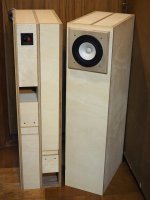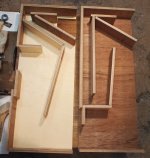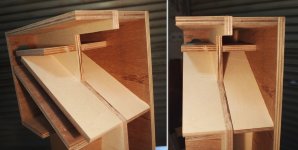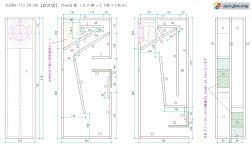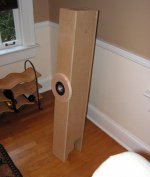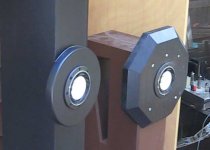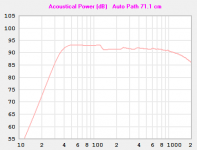This enclosure has a unique construction and does not use sound absorbing materials.
Compared to enclosures of other structures, it produces a unique sound.
Compared to enclosures of other structures, it produces a unique sound.
Attachments
No damping material?
Sounds great with headphones.
Why is damping material not needed?
I see two different channels with different tuning.
Interesting.
Sounds great with headphones.
Why is damping material not needed?
I see two different channels with different tuning.
Interesting.
Why is damping material not needed?
That is because it is a "dumping material-free box".
Advantages of no dumping material
・cost down
・simple build
・powerful and dynamic sound
・effective use of the sound from the back of the cone (high efficiency)
This enclosure has a unique construction and does not use sound absorbing materials.
Compared to enclosures of other structures, it produces a unique sound.
I don't understand this cabinet design. The split design part, OK, I understand what it's goal likely is.
But it's not really a "horn" right? because both of the the exits of the cabinet are small.
Normally with a back-horn design, the back wave channels expand to it's maximum size at the exit point of the cabinet.
But here it does not. So it's some kinda of hybrid horn-BR/TL design?
Also the dual/split BH design, is a much more complicated to build so presumably there is a big advantage here?
Last edited:
That is because it is a "dumping material-free box".
Advantages of no dumping material
・cost down
・simple build
・powerful and dynamic sound
・effective use of the sound from the back of the cone (high efficiency)
@nandappe Have you ever experimented with adding a big supraBaffle ?
You could try using styrofoam (styrene sheet) material first until you find the size and shape you like then build them with wood.
https://www.diyaudio.com/community/threads/suprabaffles-wavelaunch.86636/post-1005557
Last edited:
It looks unnecessary complicated 12 and 26 could be replaced by an extension of 11 and 21 and 28 by an extension of 18.
Otherwise it is a quarter wave pipe/transmission line. The positive flare lower the Q of the fundamental resonance and also increase the frequency compared to a straight pipe. The constriction at the opening offset the increase in frequency. If the pipes work independently the dips and peaks due to harmonics will occur at different frequencies for the two pipes and then hopefully improve the sound compared to a "mono pipe"
It would be interesting to see some measurements of pipe output and nearfield measurements of the driver. My Decca corner horn sounded surprisingly good without any damping material in it, so it might work.
Otherwise it is a quarter wave pipe/transmission line. The positive flare lower the Q of the fundamental resonance and also increase the frequency compared to a straight pipe. The constriction at the opening offset the increase in frequency. If the pipes work independently the dips and peaks due to harmonics will occur at different frequencies for the two pipes and then hopefully improve the sound compared to a "mono pipe"
It would be interesting to see some measurements of pipe output and nearfield measurements of the driver. My Decca corner horn sounded surprisingly good without any damping material in it, so it might work.
@nandappe Have you ever experimented with adding a big supraBaffle ?
You could try using styrofoam (styrene sheet) material first until you find the size and shape you like then build them with wood.
https://www.diyaudio.com/community/threads/suprabaffles-wavelaunch.86636/post-1005557
supra baffle examples 👇 Do they make much difference in the sound? I don't know 🤔
Attachments
Last edited:
Gonna be a tight fit. You'll probably need to double up on the baffle thickness (or suprabaffle maybe) at the driver location. CHP-90 has a much larger Vas than typical 4" drivers, so might actually work better in FHXL. Dave will know.Has anyone tried this driver in a Frugel-horn?
jeff
@nandappe I listened to this recording compared to your recording of the SB20FRPC30-8 + DDVP-20 with the same music and I hear no big differences. Maybe in front of them (not over Youtube) you can hear big differences?
Anyway, I think that says a lot that the CHP-90 in this cabinet can have bass response essentially equal to the SB 8" driver. But this makes me wonder if maybe the DDVP-20 isn't the most ideal cabinet for the SB 8" driver?
I don't understand this cabinet design. The split design part, OK, I understand what it's goal likely is.
But it's not really a "horn" right? because both of the the exits of the cabinet are small.
Normally with a back-horn design, the back wave channels expand to it's maximum size at the exit point of the cabinet.
But here it does not. So it's some kinda of hybrid horn-BR/TL design?
Duct attached to horn openings are effective in "alleviating BH quirks and improving loose bass" and have been used since the 1990s.
Have you ever experimented with adding a big supraBaffle ?
You could try using styrofoam (styrene sheet) material first until you find the size and shape you like then build them with wood.
I do not need a "Big Supra-Baffle". I want my baffle to be as small as possible.
Duct attached to horn openings are effective in "alleviating BH quirks and improving loose bass" and have been used since the 1990s.
can you show some examples?
how do we interpret that .txt file? Where is it explained how to build a MLTL from the values in that file?FYI/FWIW, a SB20FRPC30-8 max flat MLTL.
You must install Hornresp and IMPORT the file to see all the construction data, sims, etc..
OK. I use Linux not Windows but I'll try it in a VM or with Wine.You must install Hornresp and IMPORT the file to see all the construction data, sims, etc..
Being strictly Windoze, don't pay attention, but IIRC the various ways to use HR on other software can be found here.
It runs fine in a Virtualbox Windows 10 VM (virtual machine). Now I just gotta learn how to use HR 🤔
- Home
- Loudspeakers
- Full Range
- MarkAudio CHP-90 mica + SDDBH-T13.5R-AD (Dual Back-loaded Horn adding adjustable Duct, no sound absorber)
